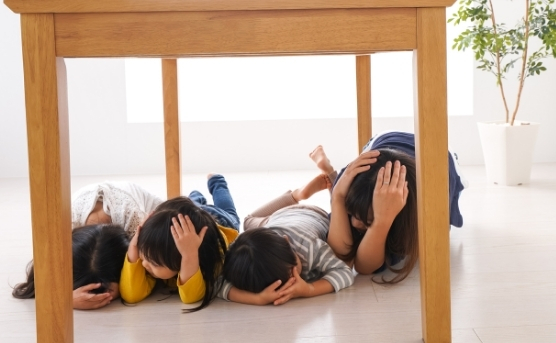Earthquakes
Disasters and Emergencies
Earthquakes
Although earthquakes in Iowa are extremely rare, the threat exists nontheless. All Iowans should learn the basics when it comes to preparing for and protecting themselves from an earthquake.
Earthquakes themselves rarely cause death or injury. Most casualties occur when buildings collapse or by falling objects and debris. For these reasons, it is important to know where you should seek shelter when the ground begins to shake.
For more information on earthquake safety, visit the FEMA website.
- Learn about/participate in the Great Central U.S. ShakeOut.
- Learn about the New Madrid Seismic Zone.
- Visit the Central U.S. Earthquake Consortium website.
For information about earthquakes in Iowa, visit the Iowa Department of Natural Resources website.

Know what to do before, during, and after an earthquake.
Iowa disaster history
How many Earthquakes have
happened in Iowa?
Information: Iowa Dept. of Natural Resources, from the September/October 2011 issue of Iowa Outdoors magazine
Iowa doesn’t have any major fault lines, but we have had at least 13 earthquakes with epicenters within our borders. The largest Iowa earthquake shook Davenport in 1934, and Iowans felt the most recent quake southwest of Shenandoah in 2004. Iowa was one of only four states that did not have an earthquake between 1975 and 1995. Earthquakes aren’t common here in Iowa, but they do happen.
READY IOWA has resources that you can share on social media to promote earthquake preparedness in your home and community.

Drop, Cover, and Hold!
BEFORE, DURING, & AFTER AN EARTHQUAKE
PREPARING FOR AN EARTHQUAKE
Safe Spots
The best places to be in the event of an earthquake are:
- Under heavy pieces of furniture such as a desk or sturdy table
- Under supported archways
- Against inside walls
Danger Spots
Be aware of the dangers associated with:
- Breaking window glass
- Falling objects
- Falling mirrors
- Falling chimneys
- Toppling of tall, unsecured pieces of furniture
DURING AN EARTHQUAKE
If you are inside
- Drop, Cover, and Hold. Take cover under a sturdy desk, table, or bench, or against an inside wall, and hold on. If there is no desk or table near you, cover your face and head with your arms and crouch in an inside corner of the building.
- Stay away from glass, windows, outside doors and walls, and anything that could fall, such as lighting fixtures and furniture.
- If you are in bed when the earthquake strikes, stay there. Hold on and protect your head with a pillow, unless you are under a heavy light fixture that could fall. In that case, move to the nearest safe place.
- Stay inside until the shaking stops and it is safe to go outside. Most injuries during earthquakes occur when people are hit by falling objects while entering or leaving buildings.
- Be aware that electricity may go out or that sprinkler systems or fire alarms may turn on.
- Do not use elevators.
If you are outside
- Stay there.
- Move away from buildings, trees, streetlights, and utility wires.
If you are in a car
- Stop as quickly as safety permits, pull to the side of the road, and stay in the car.
- Use a GPS tracking device or satellite messenger to send an emergency assistance request if there is a severe medical emergency. A satellite messenger device is an advanced GPS, which is able to send your exact GPS coordinates and selected messages over commercial satellites to tell others of your location and status.
- Avoid stopping near or under buildings, trees, overpasses, and utility wires.
- Do not attempt to drive across bridges or overpasses that have been damaged.
- Proceed cautiously after the earthquake has stopped, watching for road and bridge damage.
If you are trapped under debris
- Do not light a match.
- Cover your mouth with a handkerchief or clothing. Do not move about or kick up dust.
- Tap on a pipe or wall so that rescuers can find you. Use a whistle if no one is available. Shout only as a last result – shouting can cause you to inhale dangerous amounts of dust.
AFTER AN EARTHQUAKE
- If you are in a damaged building, go outside and quickly move away from the building. Do not enter damaged buildings.
- Check yourself to see if you are hurt and help others if you have training.
- If you are sick or injured and need medical attention, contact your healthcare provider for instructions.